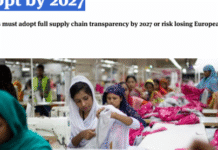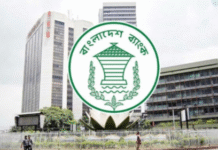Faruque Ahmed
The budget for fiscal 2016-17 at a proposed cost of Tk 340,000 crore shows the government desperation to attain rapid GDP growth breaking the 7 percent trajectory to reach the country to the middle income status by 2021. It projected 7.2 percent growth for next year with inflation to be around 5.8 percent.
It is 29 percent bigger in size from last year’s budget on year on year basic to suggest the biggest leap forward in largely higher expenditure targets based on bigger but uncertain revenue targets.
The revenue target over Tk 241,000 crore which is 35.4 percent higher than that of last year’s and it has prompted economists and analysts alike to wonder how the National Board of Revenue (NBR) will be able to mobilize the fund on time.
Muhith admits: It’s ambitious
The NBR’s revenue shortfall last year was TK 30,000 crore from the original target and the new target has therefore surprised many to suggest that it is a highly ambitious target and lacks coherence with the ground reality.
Finance Minister AMA Muhith also agreed that it is an ambitious target and its implementation too is ambitious for achieving higher growth. But he appears convinced that the BNR has achieved enhanced capacity to mobilize the additional resources for this purpose.
The budget details say that it is built on an overall deficit of Tk 97,933 crore and looking at the annual development program (ADP) at a proposed cost of Tk 110,000 crore, one may draw the conclusion that, allowing internal budgetary adjustments, nearly the whole ADP is based on borrowing. That is, the future generation will have to bear the cost of today’s development and given the pervasive corruption and misuse of fund without transparency and accountability, we are creating unbearable debts for them.
It is known that the real value of a taka in government development projects now stands between 40 to 50 poisha and the question whether such poor quality of public expenditure can justify indiscriminate borrowing against future. Borrowing is justified when it creates enough resources to outweigh the load on future tax payers. The budget proposals has targeted Tk 61,548 crore borrowing from domestic sources which included Tk 38,930 crore from banking in addition to Tk 22,610 crore from selling national saving certificates. Moreover, it looks forward to secure Tk 36,305 crore from external aid next year.
It appears that the budget is changing character in recent years. The development assistance figure of the Economic Relations Division (ERD) suggests that the country has already a huge stockpile of foreign aid resources staggering over $23 billion and much of the pipeline is growing because of the government’s poor capacity to use the resources.
Govt.’s ambivalence on aid
Interestingly, the development ministries in recent years are demanding more allocations for their projects in local currency funding instead of utilizing foreign aided fund. This is creating the twin pressure on the NBR for arranging such funds which leads to inflating the huge unused aid pipeline.
It may partly explain why the finance minister is impatient to collect more revenue through NBR and non-NBR sources while the crisis of accelerating the use of bulging foreign aid pipeline is also haunting the government.
The government is trying to enlist more tax payers while it is also working to reform the tax system such as making VAT payment by business at 15 percent flat rate which the business leaders say to be highly discriminatory and also to overload the business. But since the end user pay the tax, such measure will affect more the poor users of salt and sugar than luxury goods used by the rich who can arguably afford.
The finance minister’s argument is that a target is not what can be totally achieved and bigger target allows the government to beat it machinery to run after it to achieve as much as possible. But many fear that in doing so the government’s excessive drive for more revenue may seriously harass the business and common people.
They also believe that a big budget does not mean big development. There must be good governance, check on corruption and increasing the capacity of the government and efficiency of its bureaucracy to ensure better use of the resources. The budget lacks clear guideline how fiscal discipline can ensure proper use of the budget.
It is a quite critical issue when government report said 40 percent of the ADP was implemented in nine months up to Match this year and then only about 90 percent ADP implementation was possible over the next three years.
Targets: Will-o’-the wisp?
Most observers believe that the high pay scale of government servants will eat up the major part of the bigger budget without helping the government to put the money to productive sectors of the economy.
Our GDP calculation is based on use of public and private resources on economic activities which also include hefty pay bill to members of the bureaucracy. Only 1.2 million government servants benefit from such hefty pay scale although it pulls the overall growth rate significantly up.
Private sector growth has remained largely stalled because of the high interest rate, political risk to investment which is also causing setback to FDI inflow. Non-availability of gas, electricity and land for new investments and necessary infrastructure are also dampening all efforts. As a result the public sector-led growth has been stronger in the past several years with private sector-led growth slowing down.
The budget has proposed highest allocation to communication and energy sector development to mitigate these problems. But the huge allocation to mega projects without proper mechanism to check misuse and even stealing of fund remains the biggest problem to proper implementation of the budget. Reports said the cost of a kilometre of flyover is highest in Bangladesh than in India and China.
Proposals for higher allocation to education and health sector are expected to create better human resources and better health care for the people to raise productivity. But again, proper use of the fund remains the biggest issue to bring about the desired results.
The budget should create the environment to create more jobs in the economy when increased joblessness is a threat. The economy produce 1.2 million jobs annually since 2003 but it fell to only three lakhs from 2013. The budget must contribute to create enabling environment in the economy. The budget’s focus on better safety program for the poor is also good but reaching the benefits to the poor need to be ensured.
Source: Weekly Holiday









